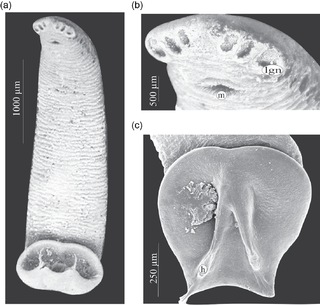
The broadfin shark is a tropical whaler shark, characterized by the broad shape of its pectoral fins. They are classified as requiem sharks of the family Carcharhinidae. This is one of two species in the genus Lamiopsis, the other being the Borneo broadfin shark. The broadfin shark is native to the northern Indian Ocean, and is found close to shore. Its current status according to the IUCN is endangered.

The blacktailed spurdog is a dogfish, a member of the family Squalidae, found around New Caledonia in the central Pacific Ocean, at depths from 320 to 320 m. Its length is up to 75 cm.

The pale-edged stingray or sharpnose stingray is a species of stingray in the family Dasyatidae, found in the Indian and Pacific Oceans from India to the western Malay Archipelago and southern Japan. This bottom-dwelling ray is most commonly found over sandy areas shallower than 100 m (330 ft), as well as in estuaries. Measuring up to 29 cm (11 in) across, the pale-edged stingray has a diamond-shaped pectoral fin disc, a long projecting snout, small eyes, and a whip-like tail with both dorsal and ventral fin folds. It is chocolate brown above and white below.

The longtail butterfly ray is a species of butterfly ray, family Gymnuridae, native to the Indo-Pacific from the Red Sea to southern Japan and western Indonesia. Growing up to 92 cm (36 in) across, this ray has a lozenge-shaped pectoral fin disc about twice as wide as long, colored brown to gray above with many small, light spots. The spiracles behind its eyes have smooth rims. This species can be identified by its tail, which is about as long as the snout-to-vent distance, lacks fins, and bears nine to twelve each of alternating black and white bands.
Mediorhynchus is a genus of small parasitic spiny-headed worms. Phylogenetic analysis has been conducted on two known species of Mediorhynchus and confirmed the placement along with the related genus Gigantorhynchus in the family Gigantorhynchida. The distinguishing features of this order among archiacanthocephalans is a divided proboscis. This genus contains fifty-eight species that are distributed globally. These worms exclusively parasitize birds by attaching themselves around the cloaca using their hook-covered proboscis. The bird hosts are of different orders.
Notoporus is a genus of trematodes in the family Opecoelidae.

Opecoelidae is a family of trematodes. It is the largest digenean family with over 90 genera and nearly 900 species, almost solely found in marine and freshwater teleost fishes. It was considered by Bray et al. to belong in the superfamily Opecoeloidea Ozaki, 1925 or the Brachycladioidea Odhner, 1905.

Monocotylidae is a family of monogenean flatworms.

Pseudorhabdosynochus is a genus of monopisthocotylean monogeneans, included in the family Diplectanidae. The type-species of the genus is Pseudorhabdosynochus epinepheli .

The Diplectanidae are a family of monopisthocotylean monogeneans. They are all parasitic on the gills of fish. Diplectanids are small animals, generally around 1 mm in length. As parasites, they can be extremely numerous, up to several thousand on an individual fish.
Acanthobothrium bullardi is a species of parasitic onchobothriid tapeworm first found in the whiptail stingray, Dasyatis brevis, in the Gulf of California. This species of parasitic tapeworm was originally discovered alongside four other varieties of tapeworms in the Gulf of California during a survey of the area that was done in the years 1993 as well as 1996. Information on this discovery can be found in greater detail in the article written by Sohini Ghoshroy and J.N. Caira titled "Four New Species of Acanthobothrium from the Whiptail Stingray Dasyatis Brevis in the Gulf of California, Mexico". This article claims itself as the first document with record on these tapeworms in California. Although this particular variety has only been discovered on the bodies of whiptail stingray, other Acanthobothrium species have been found on the bodies of many more animals including sharks. This is described in the article written by Caroline Fyler titled "Systematics, biogeography and character evolution in the tapeworm genus Acanthobothrium van Beneden, 1850 ".

Thomas Harvey Johnston was an Australian biologist and parasitologist. He championed the efforts to eradicate the invasive prickly pear.
Haemaphysalis hystricis, the East Asian mountain haemaphysalid, is a hard-bodied tick of the genus Haemaphysalis. It is found in India, Sri Lanka, Vietnam, Myanmar, China, Japan, India, Indonesia, Laos, Taiwan and Thailand. It is an obligate ectoparasite of mammals. It is a potential vector of Kyasanur Forest disease virus, Coxiella sp., Ehrlichia sp., and Rickettsia japonica. In 2007, an unknown trypanosoma species known as Trypanosoma KG1 isolate was isolated from naturally infected H. hystricis ticks.
Dactylomyza is a genus of trematodes in the family Opecoelidae.
Discoverytrema is a genus of trematodes in the family Opecoelidae. K. Zdzitowiecki described both species of Discoverytrema as being endoparasitic in the Antarctic gadiform fish Muraenolepis microps Lönnberg, 1905, which are found to the south of the British South Georgia Island.
Neonotoporus is a genus of trematodes in the family Opecoelidae.

František Moravec is a Czech parasitologist who specialises on the Nematodes, especially the nematodes parasites of fishes. His research is mainly in the field of taxonomy of the Nematoda.
Delane C. Kritsky is an American parasitologist who specialised on the Monogenea, a class of parasitic flatworms which are important ectoparasites of fishes. His research was mainly in the fields of taxonomy, faunistics, and phylogeny of the Monogenea.
Pseudodiplectanum is a genus of monopisthocotylean monogeneans, belonging to the family Diplectanidae. Species of Pseudodiplectanum are parasites of marine teleost fish.








